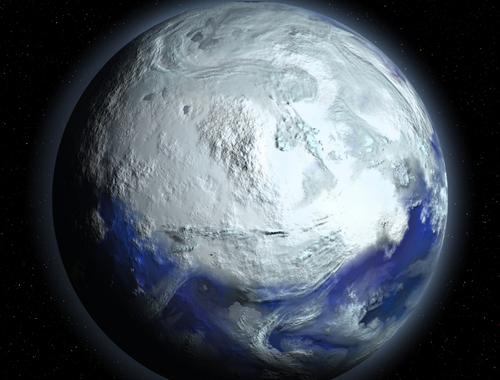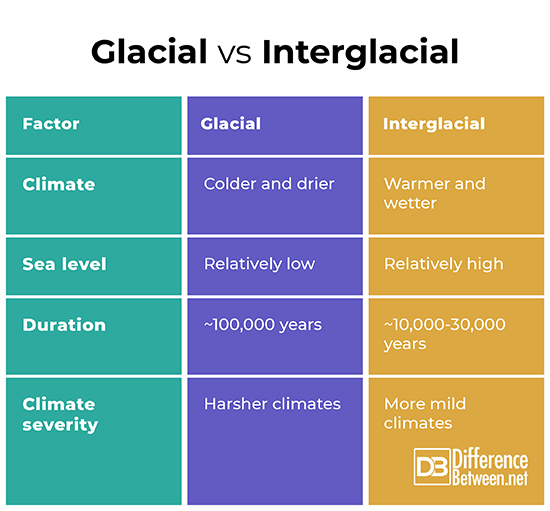Difference Between Glacial and Interglacial

Glacial vs Interglacial Period
A glacial period refers to a period during which significant portions of the planet’s land surface are covered in large ice sheets. The last glacial period lasted from 120,000 years ago to about 11,500 years ago. During this period, ice sheets covered much of the northern hemisphere continents. Glacial periods are also referred to as ice ages.
Ice ages are characterized by cold temperatures and dry, dusty climates. Glacial periods also tend to coincide with periods of relatively low sea level since significant amounts of the planet’s water are locked up in ice sheets and glaciers.
Beginning 800,000 years ago, ice ages began to last about 100,000 years at a time. Before this point in time, they were only about 41,000 years long. The reason for this change is not entirely clear to climate scientists.
Ice ages in the past probably have driven evolutionary change. Ice age conditions may have contributed to human evolution in creating harsh conditions which required greater intelligence to face. This may have resulted in the evolution of more advanced cognition in pre-human ancestors.

Interglacial (period)
The opposite of a glacial period
Interglacials are the intervals between glacial periods characterized by warmer temperatures, sea level rise, and the retreat of ice sheets and glaciers. The warming events that lead to interglacial periods tend to be abrupt.
All the history of human civilization has occurred within a single interglacial period, the Holocene. The Holocene interglacial began 11,500 years ago.
When will the next glacial period, or ice age, begin?
Interglacials typically have lasted 10,000-30,000 years. Typically, they have been characterized by a stable, warm climate for about 10,000-15,000 years before slowly transitioning back into a glacial period. Before anthropogenic climate change from greenhouse gas emissions, it could have been argued that the next ice age would probably begin in the next 20,000 years. Because of climate change, however, the next ice age probably will not begin for at least 50,000 years if not longer. The only way it would happen sooner is if the atmospheric concentration of greenhouse gases was reduced to pre-industrial levels.
Similarities between glacial and interglacial
What causes glacial and interglacial periods?
Glacial and interglacial periods are both caused by cyclic changes in Earth’s orbit and spatial orientation as it orbits the sun, or the Milankovitch cycles. Milankovitch cycles, predicted by the Serbian scientist Milutin Milankovitch (1879-1958), are cyclic changes in the shape of Earth’s orbit (eccentricity), the orientation of Earth with respect to the sun (axial precession), and its axial tilt (obliquity).
The longest of these cycles is the eccentricity cycle, which lasts 100,000 years. Over 100,000 years, Earth’s orbit will go from its minimum eccentricity, where it is nearly circular, to its maximum eccentricity, where it is at its most elliptical, and back to a state of minimum eccentricity. The difference in solar radiation between aphelion (farthest point from the sun in Earth’s orbit) and perihelion (closest point to the sun in Earth’s orbit) will not be significant and thus will have only a small effect on the seasons. Currently, perihelion occurs in January during the northern winter and aphelion occurs in July during the northern summer.
Axial precession refers to the change in the orientation of Earth’s axial tilt with respect to the sun. In other words, axial precession refers to the way that Earth “wobbles,” like a spinning top, as it orbits the sun. This cycle lasts about 26,000 years. Axial precession essentially determines where in Earth’s orbit one planetary hemisphere is tilted towards the sun and where in Earth’s orbit that same hemisphere is tilted away from the sun. From a northern hemisphere perspective, Earth is currently tilted away from the sun during perihelion and is pointed towards the sun at aphelion. Axial precession means, that at different points in Earth’s history, the northern hemisphere would have been tilted towards the sun at perihelion and away from the sun at aphelion. Today, Earth being slightly closer to the sun during northern winter and slightly farther from the sun during northern summer creates slightly milder seasonal differences in the northern hemisphere than would otherwise be the case. Conversely, the southern hemisphere summer is slightly hotter than it would otherwise be since it occurs while Earth is at perihelion.
Obliquity refers to changes in the magnitude of Earth’s axial tilt. Currently, Earth is tilted at about 23.4 degrees with respect to the plane of its orbit around the sun, the ecliptic. It is currently right in the middle of its obliquity range. Earth was last at its maximum obliquity about 10,700 years ago. It will be at its minimum obliquity around 9,800 years from now. Obliquity causes the seasons and controls the severity of the seasons. A higher obliquity causes larger contrasts between the seasons, meaning colder winters and hotter summers. A lower obliquity will result in more mild differences between the seasons, meaning warmer winters and cooler summers.
Whether or not the planet is in a glacial period, or an interglacial period, is significantly influenced by the interaction between the Milankovitch cycles. Where Earth is in each of these cycles determines the intensity of solar radiation at a given point on Earth’s surface and at a given latitude. These cycles, as a result, determine whether temperatures will be warmer, resulting in an interglacial period, or colder, resulting in a glacial period.
Is Earth in a glacial period or interglacial period?
Earth is currently in an interglacial period, the Holocene, and has been so for the last 11,500 years.
Differences between glacial and interglacial
Are glacial periods colder than interglacial periods?
Glacial periods are colder than interglacial periods.
Other differences
Other important differences between glacial periods and interglacial periods include the following.
- Glacial periods tend to be dry, whereas interglacial periods will have relatively wetter climates.
- Glacial periods are characterized by lower sea level, whereas interglacial periods are characterized by higher sea level.
- Interglacial periods last 10,000-30,000 years, whereas glacial periods for the past 800,000 years usually have lasted about 100,000 years.
- Glacial periods are characterized by harsher climates, whereas interglacial periods will be characterized by more mild climates, though not exclusively.
Glacial vs. interglacial

Summary
Glacial periods are periods during which significant land areas are covered in extensive ice sheets. Glacial periods are also called ice ages. Ice ages will also have climates that are drier and dustier as well as colder. They will also be characterized by lower sea level. Interglacial periods are periods during which ice sheets and glaciers retreat because of warming global temperatures. Glacial and interglacial periods are similar in that they are both caused by Milankovitch cycles, or cyclic changes in Earth’s orbital eccentricity, orientation of its axial tilt (axial precession), and obliquity. Milankovitch cycles cause variations in the intensity of solar radiation at Earth’s surface at a given latitude which in turn drive the glacial-interglacial cycle. Glacial and interglacial periods differ in that glacial periods will have colder and drier climates, lower sea level, a duration of ~100,000 years, and a greater global prevalence of harsh climates. Conversely, interglacial periods will be characterized by warmer and relatively wetter climates, higher sea level, a duration of ~10,000-30,000 years, and a greater global prevalence of mild climates.
- Difference Between Environmental Performance Index and Development - November 24, 2023
- Difference Between Environmental Intervention and Development - November 8, 2023
- Difference Between Eco Efficiency and Eco Effectiveness - September 18, 2023
Search DifferenceBetween.net :
References :
[0]Buis, Alan. “Milankovitch (Orbital) Cycles and Their Role in Earth's Climate.” NASA Global Climate Change, https://climate.nasa.gov/news/2948/milankovitch-orbital-cycles-and-their-role-in-earths climate/#:~:text=A%20century%20ago%2C%20Serbian%20scientist,glaciation%20periods%20(Ice%20Ages). Accessed 17 Sept. 2022.
[1]“Glacial-Interglacial Cycles.” NOAA, n.d., https://www.ncei.noaa.gov/sites/default/files/2021-11/1%20Glacial-Interglacial%20Cycles-Final-OCT%202021.pdf.
[2]“How long can we expect the present Interglacial period to last?” USGS, n.d., https://www.usgs.gov/faqs/how-long-can-we-expect-present-interglacial-period-last.
[3]Sullivan, C. “Characterizing Interglacial Periods over the Past 800,000 Years.” Eos, 2 Mar. 2016, https://eos.org/research-spotlights/characterizing-interglacial-periods-over-the-past-800000-years. Accessed 17 Sept. 2022.
[4]Walters, Sam. “How Humans Survived the Ice Age.” Discover Magazine, 9 Dec. 2021, https://www.discovermagazine.com/planet-earth/how-humans-survived-the-ice-age. Accessed 17 Sept. 2022.
[5]Water Science School. “The coastline of the eastern U.S. changes....slowly.” USGS, https://www.usgs.gov/media/images/coastline-eastern-us-changesslowly#:~:text=During%20the%20last%20ice%20age%20glaciers%20covered%20almost%20one%2Dthird,higher%20than%20they%20are%20now. Accessed 17 Sept. 2022.
